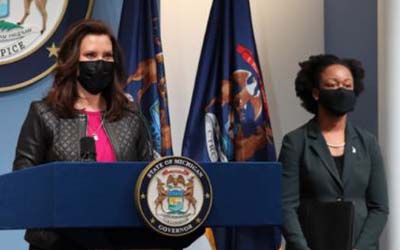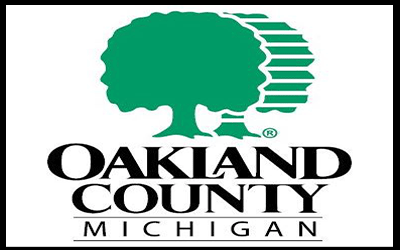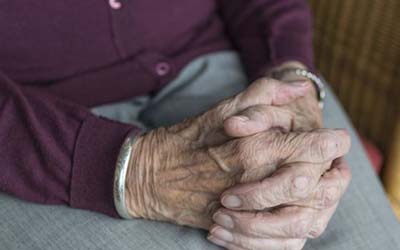
Update on the COVID-19 Vaccinations and Variants

|


|

Impact of American Rescue Plan Act on State and Local GovernmentsOn March 11, 2021, President Joe Biden signed the American Rescue Plan Act of 2021 (“ARPA”), which contains $1.9 trillion in overall national spending to support relief and economic recovery efforts. ARPA provides a total of $350 billion in assistance to states, counties, municipalities, territories and tribal governments to cover expenses, make up for lost revenue and ease the overall economic impact from the COVID-19 pandemic. The Basics
Timing
Use of Funds
Michigan will receive a total of $10.6 billion in state and local relief, with $6.6 to be distributed to the state government and $4 billion allocated to local governments within the state. Illinois will receive $13 billion total, with $7.5 billion going to the state government and $5.5 billion allocated to local governments. Please contact the authors or your Miller Canfield attorney with additional questions. This information is based on facts and guidance available at the time of publication and may be subject to change. |
||||

“Oakland County has a quality of life that endures because of its 1,450 lakes, 138 miles of trails, 90,000 acres of parks, and headwaters of five watersheds that flow throughout Southeast Michigan,” Coulter said. “We have a responsibility to address climate change so future generations can enjoy better public health, a stronger economy, and our beautiful natural resources.”
Through a competitive bidding process, Oakland County has selected AECOM to cultivate the sustainability plan. The company has led the development of over 30 city and county resilience plans around the globe. It will team up with Thomas Consulting Group and Eminence Partners to assist in this large and comprehensive project.
“The primary goals of this plan are to assess where Oakland County is in our environmental sustainability efforts and focus on areas of improvement and resources,” Deputy County Executive April Lynch said. “The focus will include ensuring we have a strong plan moving forward that can be in tandem with our capital improvement planning and adjustments in our operations.”
The sustainability plan will focus on four areas: campus operations, emissions and energy, nature and ecosystems, and health and well-being. A parallel goal will be to help local communities as they develop their own plans to protect the environment.
To oversee the creation and implementation of Oakland County’s sustainability plan, county executive administration has asked the board of commissioners to use a vacated position for the chief sustainability officer. This person will serve as a strategic advisor to the county executive on environmental sustainability initiatives, develop the county’s sustainability initiatives, and lead the countywide climate action plan. The base pay will be $129,817.
“We are committed to addressing climate change, and these actions show that the board and county executive are moving swiftly to protect our environment,” Commissioner Gwen Markham of Novi said. “The new sustainability officer will bring together all aspects of sustainability across our parks, operations and future planning, and the energy audit and sustainability plan will deliver changes we can make to reduce the county campus’s carbon footprint.”
“The creation of the chief sustainability officer position is critical and will be an important new role at the county,” Commissioner Kristen Nelson of Waterford said. “Having a green initiative expert join our team is a bold step forward in our commitment to climate protection, and it is key to executing Oakland County’s sustainability initiatives and countywide climate action plan.”
The sustainability plan will begin in April of 2021 with background research, stakeholder engagement, and a sustainability asset management study. The county expects to have the final sustainability plan developed by spring of 2022. The total cost to create the plan is $575,000.
Board of Commissioner committees have approved the county sustainability plan and the chief sustainability officer position. The full board will vote on both on Thursday, March 25.

Gov. Whitmer launches the MI Tri-Share pilot program, dividing cost of child care equally between employees, their employer and the State of Michigan
March 18, 2021
Media Contact: Beata Kica, 517-614-9773
Gov. Gretchen Whitmer announced the three regional facilitator hub awardees of the MI Tri-Share Child Care Pilot Program (Tri-Share), an innovative approach to increasing access to high quality, affordable child care for working families, while also helping to retain talent and removing one major barrier to employment. Through Tri-Share, the cost of child care is shared equally by an eligible employee, their employer and the State of Michigan, with coordination being provided regionally by a facilitator hub.
“Every parent in Michigan deserves access to quality, safe, and affordable child care, and Tri-Share brings us one step closer to achieving that goal,” said Gov. Whitmer. “During my time in office, I’m proud of the steps we took to make child care more affordable for Michigan parents, including expanding access to child care for frontline workers during the COVID-19 pandemic. As a mom of two daughters, I know how critical child care is, and I will continue working with our partners, especially leaders in the business community, to ensure every parent has access to quality, affordable child care.”
Funded with a $1 million appropriation in the FY 21 budget, the program will operate initially in three regions of the state, and will be administered by the Michigan Women’s Commission, housed within the Dept. of Labor and Economic Opportunity (LEO). The three regional facilitator hubs chosen for the Tri-Share pilot are: Goodwill Industries of West Michigan, serving Muskegon County; Saginaw Intermediate School District, serving the Great Lakes Bay Region; and the United Way of Northwest Michigan, serving a five-county rural region in Northwest Lower Michigan.
“As the economy changes, child care must adapt as well. Access to child care supports both present and future generations of the workforce. If we make the investment today, we will ensure the flourishing of the next generation while meeting the needs of working parents and the businesses that seek to employ them,” said LEO Acting Director Susan Corbin.
A coalition of business and advocacy leaders, led by the Grand Rapids Area Chamber of Commerce and Representative Greg VanWoerkom (R-MI-91), championed funding for the pilot program. “It is a priority of mine to find innovative ideas in addressing affordable and accessible childcare. That is why I am proud to have been a part of an incredible effort to introduce this pilot program,” said Rep. VanWoerkom.
“Child care keeps Michigan working,” explains Rick Baker, CEO of the Grand Rapids Chamber. “Our members tell us child care is essential to having the talent West Michigan needs to thrive. That’s why we were vocal supporters of Tri-Share and additional investments in child care.”
As Tri-Share launches this month, the three regional facilitator hubs will work to ensure a successful pilot phase and partner with the state to work toward long-term sustainability. The role of the facilitator hub is to act as an intermediary between employers, families and child care providers, and to provide overall program management.
Tri-Share is the latest step Gov. Whitmer has taken to stabilize the child care industry and make care available and affordable for families. In her budget recommendation, Gov. Whitmer proposed $370 million for the expansion of childcare options providing additional supports for Michigan families by temporarily increasing the income eligibility threshold from 150% to 200% and temporarily waiving out-of-pocket copays through fiscal year 2022, with a 10 percent increase in hourly rates for child-care providers. Gov. Whitmer also proposed continuing the Tri-Share pilot with a $2.2 million investment.
“Every family wants their child to be safe, happy, healthy and learning,” said Cheryl Bergman, CEO of the Michigan Women’s Commission. “But for too many working families, quality child care is simply unaffordable. The MI Tri-Share Child Care program addresses the issue of affordability head-on by bringing employers and the state to the table together as direct stakeholders. It is a critical step in developing more opportunities to help Michigan women successfully enter or re-enter the workforce and secure long-term economic competitiveness for our state.”
Employees eligible to participate in the Tri-Share pilot must be employed by a participating employer, have an income above 150% of the Federal Poverty Line (FPL) and below 250% FPL, and not otherwise be eligible for the Child Development and Care Program (commonly called the state child care subsidy). Participating employers must agree to identify and recruit eligible employees, provide employer portion of each participating employee’s child care costs and maintain communication with the facilitator hub regarding each employee’s continued employment and eligibility.

FOR IMMEDIATE RELEASE: March 17, 2020
CONTACT: Lynn Sutfin, 517-241-2112
LANSING, Mich. – Today, the Michigan Department of Health and Human Services (MDHHS) updated its Residential Care Facilities Order to reflect recent changes in Center for Medicare and Medicaid Services guidance for visitation. The state recently rolled out an expanded visitation program, using a testing protocol to keep residents and staff safe. The updated order and accompanying guidance continues to support visitation and improve quality of life for seniors while maintaining precautions to help keep residents and staff safe. Testing is strongly encouraged prior to visitation, particularly in counties with medium or high positivity, but not required. The order goes into effect immediately.
“Throughout the pandemic we have focused on protecting vulnerable long-term care residents from COVID-19, which has required physical separation from family and other loved ones,” said Elizabeth Hertel, MDHHS director. “The new CMS guidance provides reasonable ways these facilities can safely facilitate in-person visitation to address the needs of residents.”
Michigan has made protecting the health and safety of our seniors and most vulnerable residents a top priority. The state acted quickly to slow the spread of the virus in nursing homes, followed CDC guidance, secured PPE, provided more than 1.3 million antigen tests for patients and staff, recorded results of more than 650,000 PCR tests and administered more than 270,000 vaccines for nursing home residents and staff. As a result, Michigan has a lower rate of nursing home deaths than the national average, according to an independent study conducted by the Center for Health and Research Transformation at the University of Michigan.
The order continues to require facilities to:
“While we are still very much fighting this pandemic and seeing some concerning trends in new cases and hospitalizations, these new changes align with CDC guidance and support families being able to visit their loved ones in nursing facilities,” said Dr. Joneigh Khaldun, chief medical executive and chief deputy for health. “We continue to monitor the data closely and urge Michiganders to continue doing what works to slow the spread of the disease by wearing a mask, washing their hands, avoiding crowds and making a plan to get the safe and effective COVID-19 vaccine when it is their turn.”
CMS guidance says facilities should accommodate and support indoor and outdoor visitation as long as the facility has not had a new COVID-19 case in the last 14 days. Visitors will be required to wear face masks or other personal protective equipment when required by the facility at all times. In general, visitors will need to maintain six feet from residents.
The new MDHHS Residential Care Facilities Visitation Guidance covers nursing homes, home for the aged, adult foster care facilities, hospice, substance use disorder residential and assisted living facilities.
Information around this outbreak is changing rapidly. The latest information is available at Michigan.gov/Coronavirus and CDC.gov/Coronavirus. To learn more about the COVID-19 vaccine, visit Michigan.gov/COVIDVaccine.